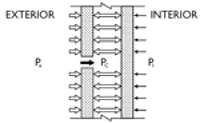Pins Direction:
Every plate regardless of dimension and architectural formation of tiles must be fixed only on four (4) anchor pins (for static reasons) and at the same direction, without crossing each other. To avoid crossing the use of half pin spade bolts is necessary.
Joints:
Joints between panels must be wide enough to accommodate thermal expansion (1mm/m2 every 50°C) and differential movements between panels. 5mm wide joints are the minimum and typically used. Joints must not sealed with mortar, sealant, epoxy etc and keep open for back ventilation no mater of water penetration as long as the thin stone wall doesn’t work like this but a rainscreen barrier. More over offer’s an advanced aesthetic effect! If decoration demand’s seal only with elastic polyurethane as silicone is prohibited, due to oil contents and stain effects at substrates.
Wind loads:
Aerodynamic pressure. Because of building aerodynamics (i.e., the interaction between the wind and the building), the highest uplift loads occur at roof corners. The roof perimeter has a somewhat lower load, followed by the field of the roof. Exterior walls typically have lower loads than the field of the roof. The ends of walls have higher suction loads than the portion of wall between the ends. However, when the wall is loaded with positive pressure, the entire wall is uniformly loaded. Figure 6 illustrates these aerodynamic influences. The negative values shown in Figure 6 indicate suction pressure acting upward from the roof surface and outward from the wall surface. Positive values indicate positive pressure acting inward on the wall surface.

Figure 1.Relative uplift pressures as a function of roof geometry, roof slope, and location on roof, and relative positive and negative wall pressures as a function of location along the wall
Aerodynamic influences are accounted for by use of external pressure coefficients, which are used in load calculations. The magnitude of the coefficient is a function of the location on the building (e.g., roof corner or field of roof) and building shape as discussed below. Positive coefficients represent a positive pressure, and negative coefficients represent negative (suction) pressure. External pressure coefficients are found in ASCE 7.
Watertight
Moisture Dynamics
The concept of the rain screen principle is to separate the plane in a wall where the rainwater is shed and where the air infiltration is stopped. In terms of construction, this means that there is an outer plane which sheds rainwater but lets air freely circulate, and an inner plane which is relatively airtight. In terms of pressures, there is no pressure differential across the outer pane and there is a significant pressure differential across the inner plane. Because there is no pressure difference across the outer plane, there is no driving force to move water indoors because there is no water present at the inner plane, no water will penetrate the inner plane despite the presence of the driving force of the pressure difference.

Threads
Blast / Earthquake / Vandalism
The building’s exterior is its first real defence against the attacks and bomb effects. It is suggested to cover the rear side of plate with glassfibre textile glued with epoxy, so the slab will remain hunged on pins (like a towel) even it has broken in pieces and don’t bacame in fragments.
In this case, rail systems offer more flexibility and absorb mutal loads.
Explosion loads act directly on the exterior envelope whereas earthquakes load buildings at the base of the building. Consequently the focus is on out of plane response for explosions and in plane response for seismic loads (see Figure 2b)


Left: Figure 2a. Seismic versus blast overlap; Right: Figure 2b. Seismic versus blast loading type.
Explosion loads are characterized by a single high pressure impulsive pulse acting over milliseconds rather than the vibrational loading of earthquakes which is acting over seconds (see Figure 2c)
Explosion loads generally cause localized damage whereas seismic loads cause global response (see Figure 2d)
Mass helps resist explosion loads whereas mass worsens earthquake response


Left: Figure 2c. Seismic versus blast loading time histories; Right: Figure 2d. Seismic versus blast response
